
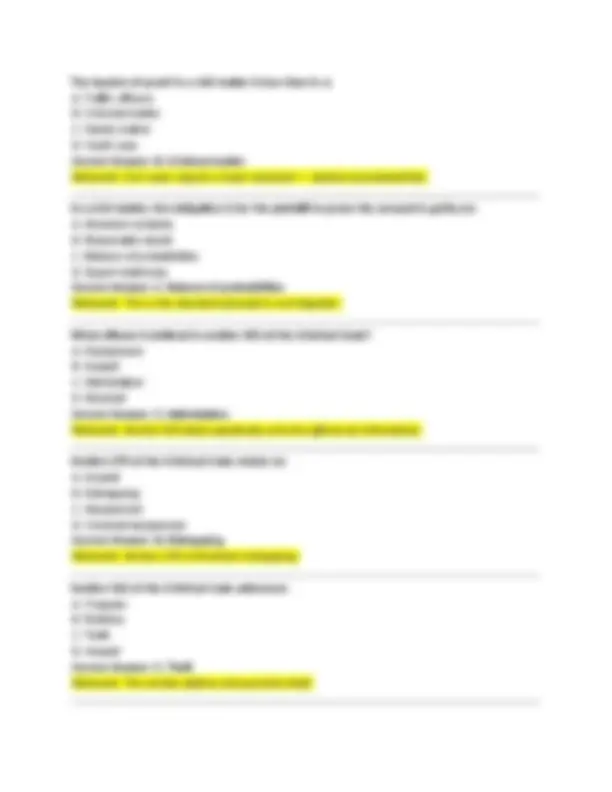
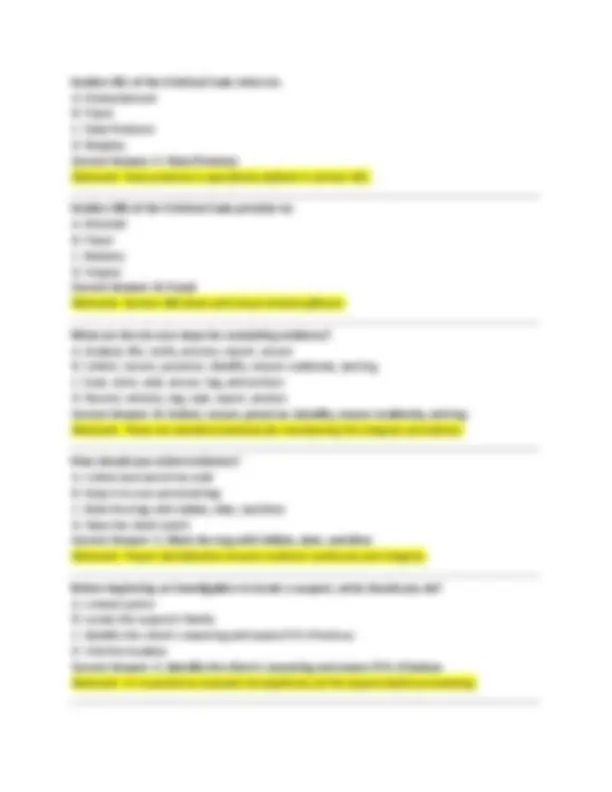
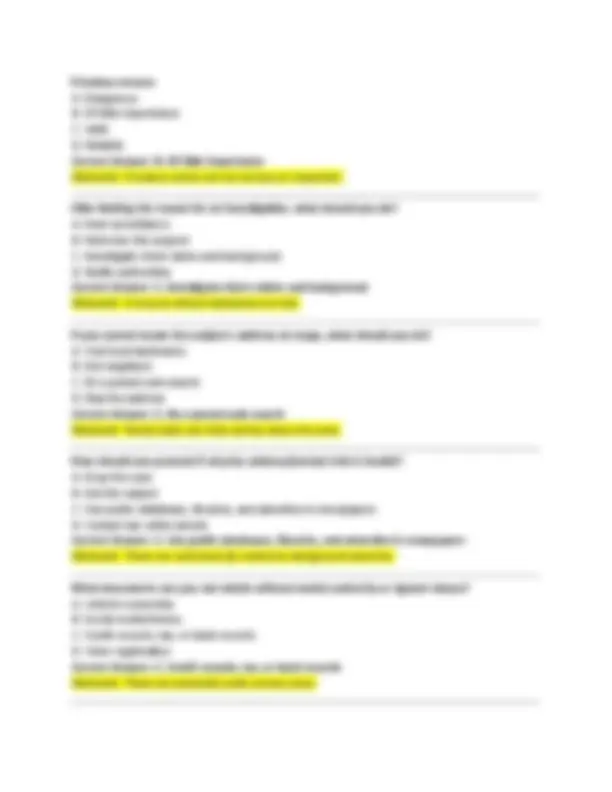
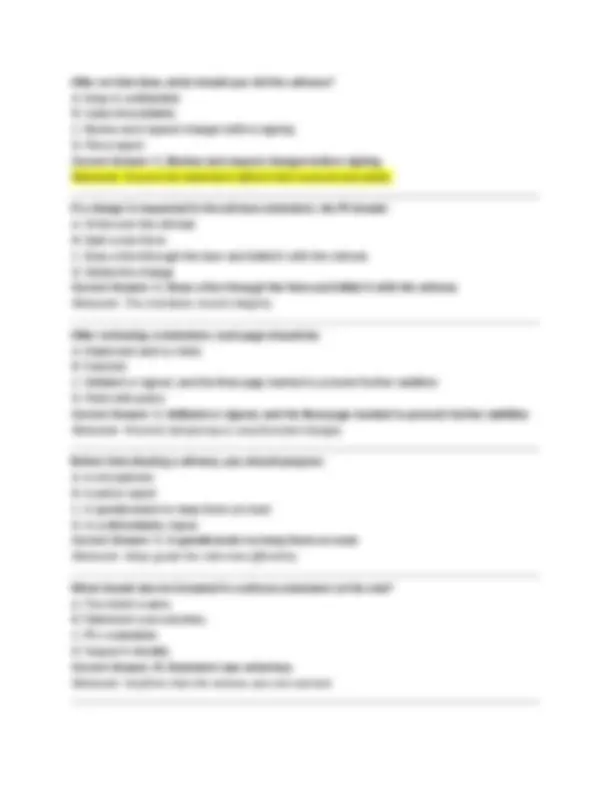
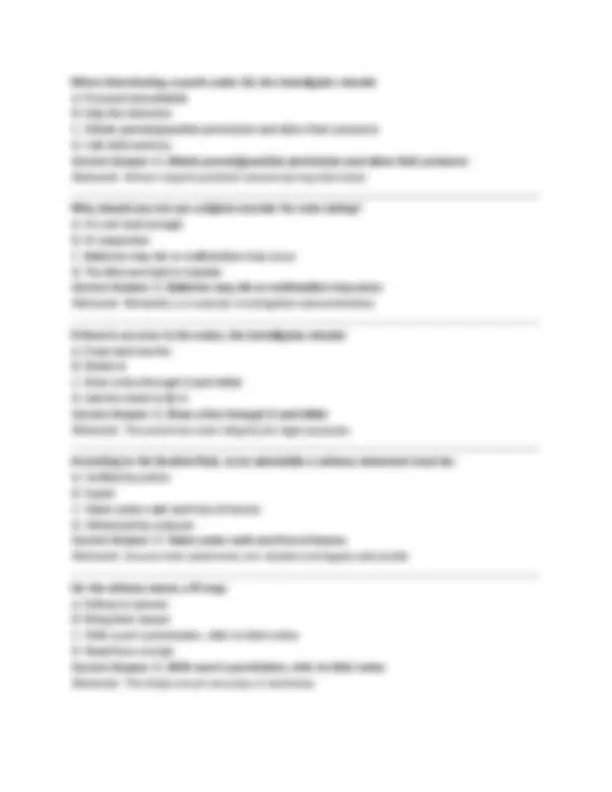
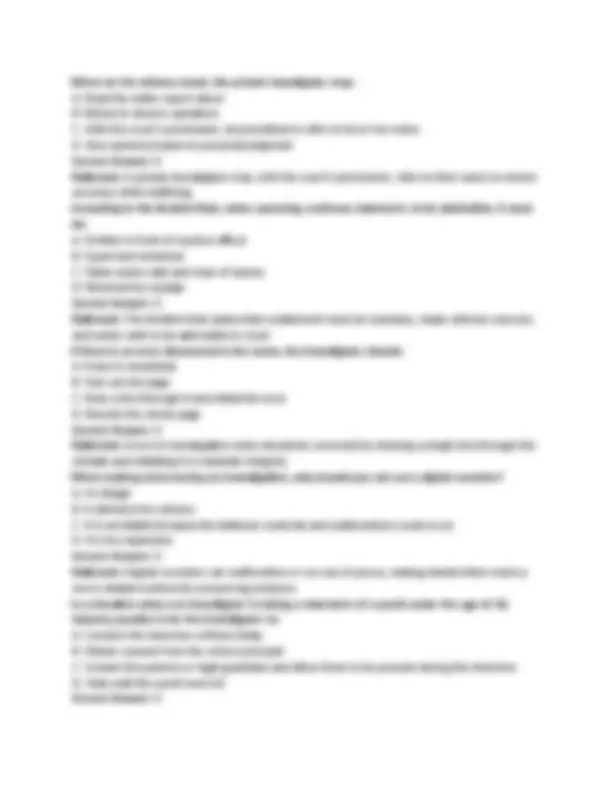
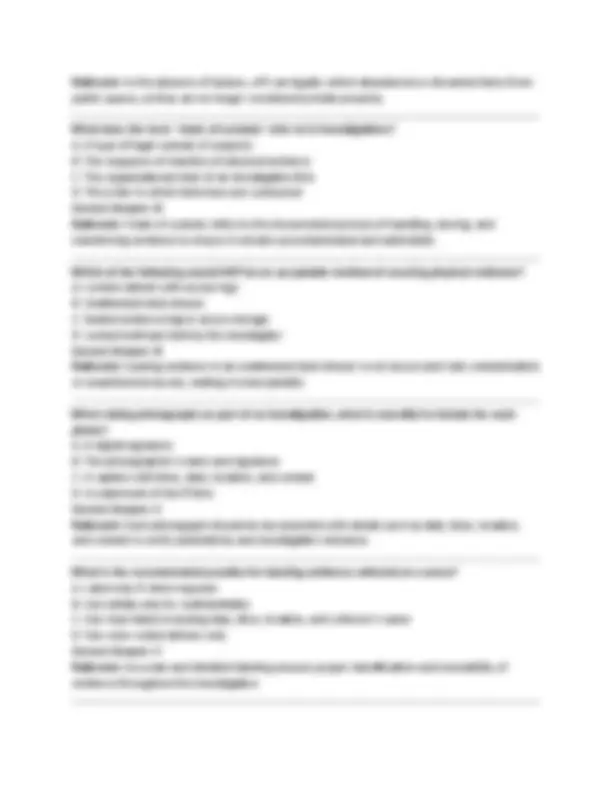
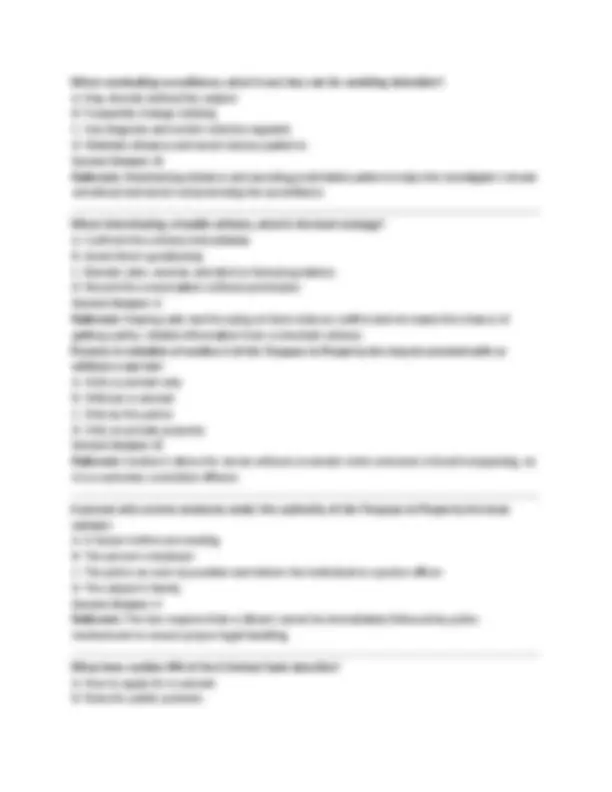
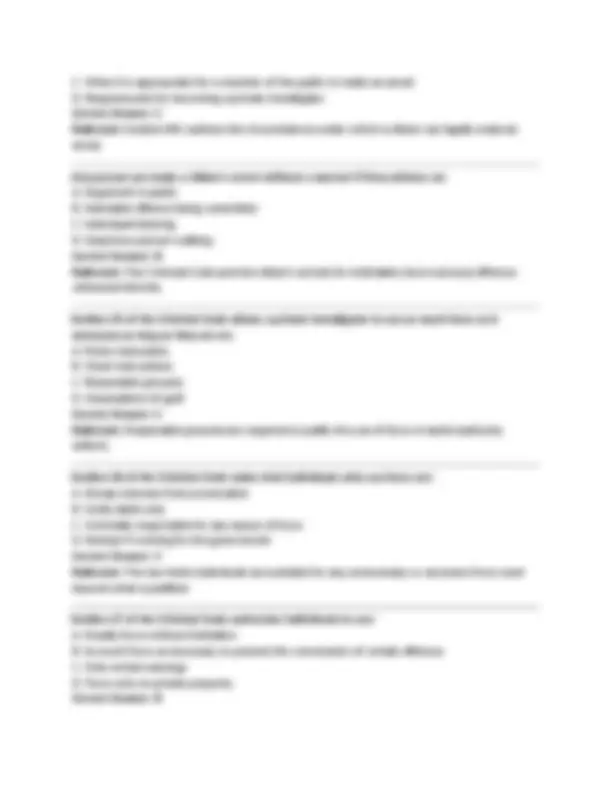
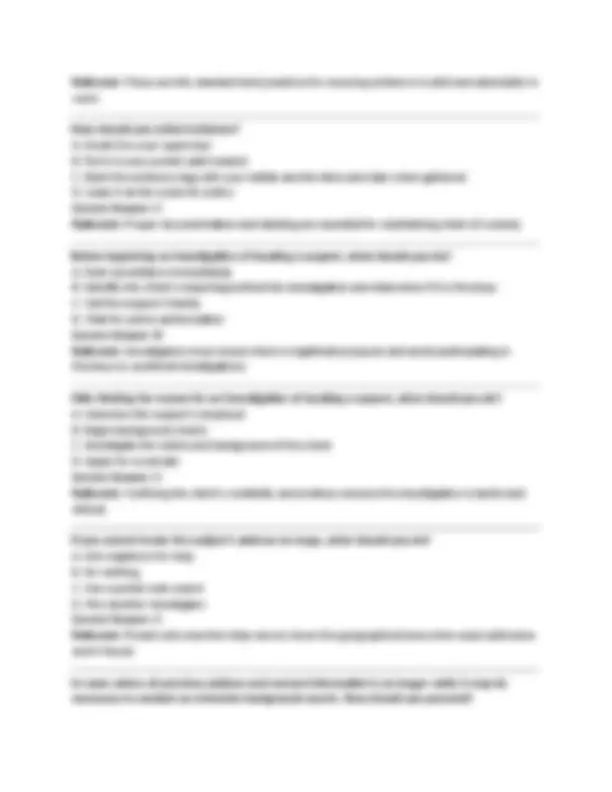
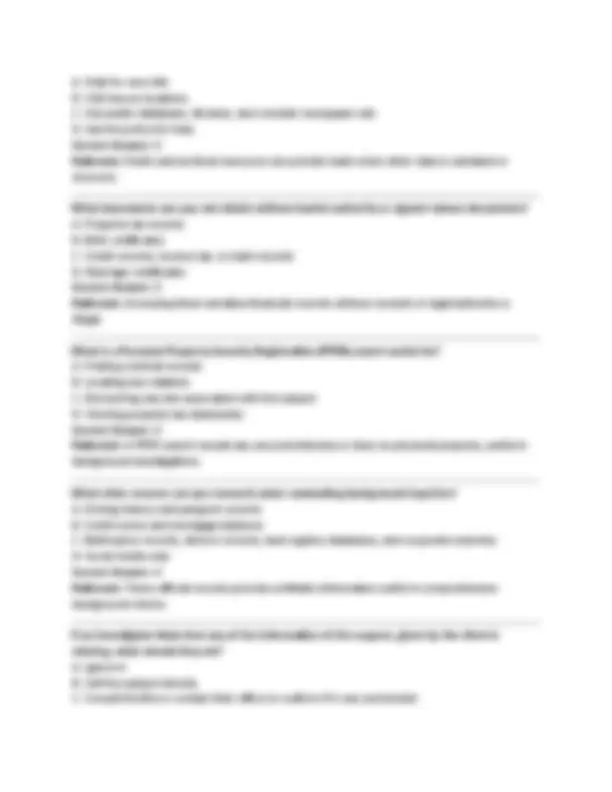
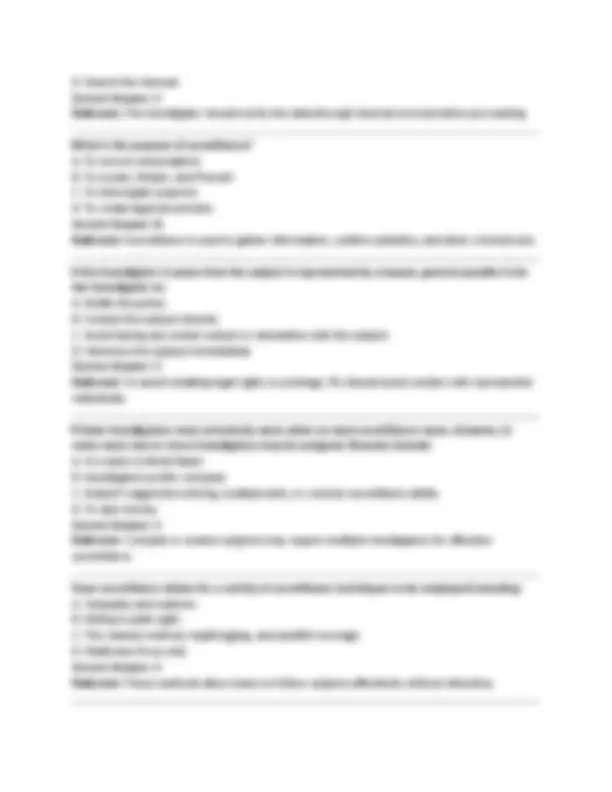
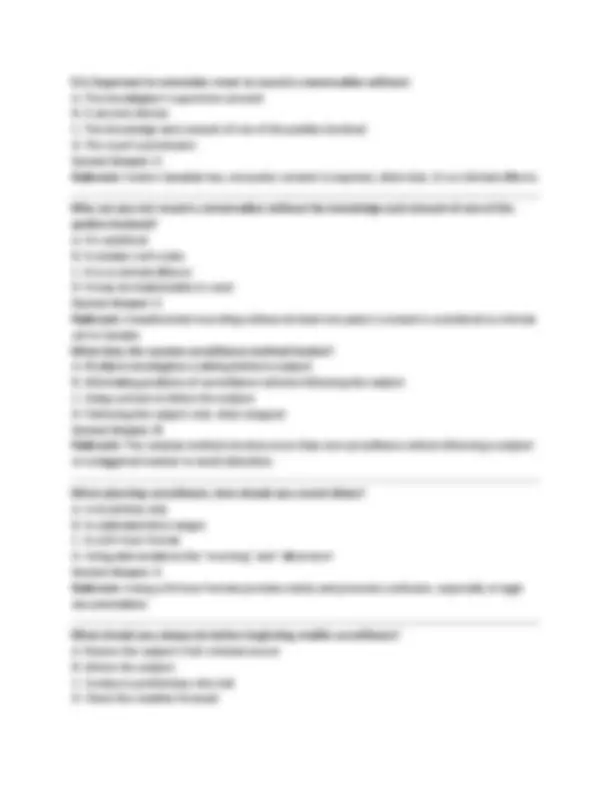
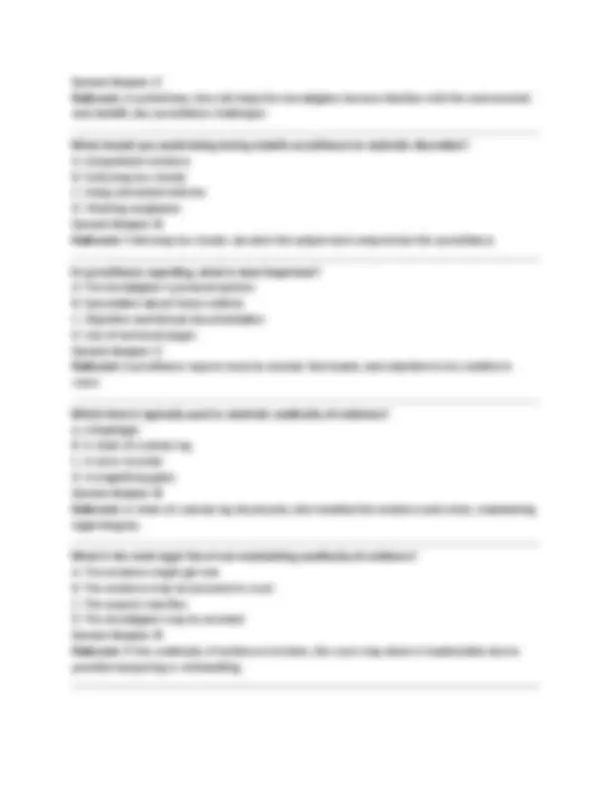
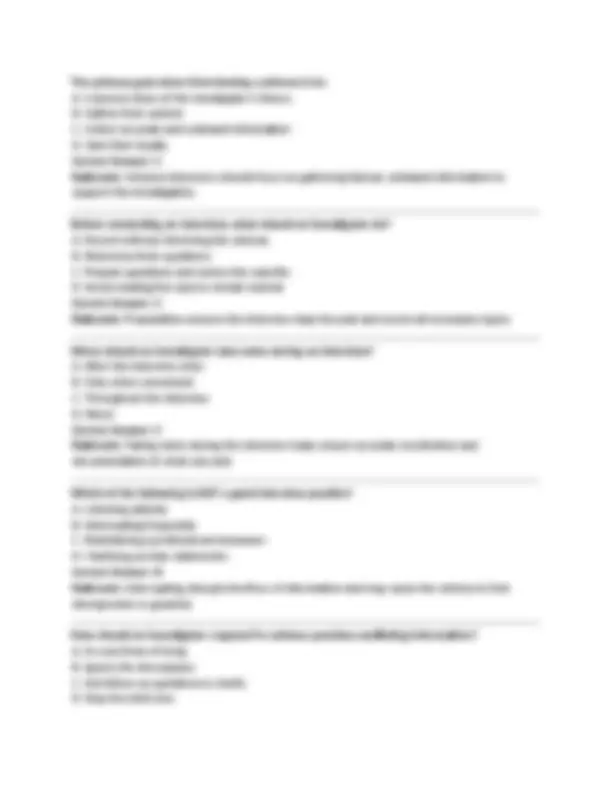
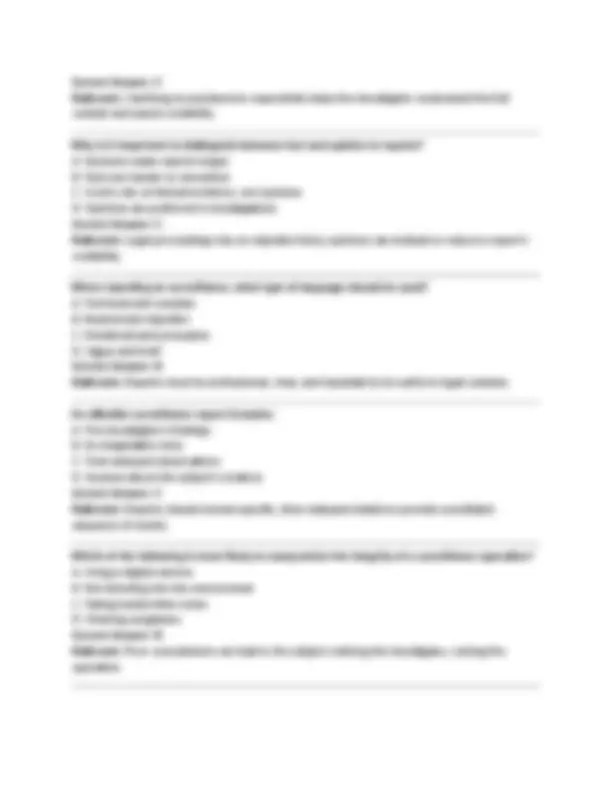
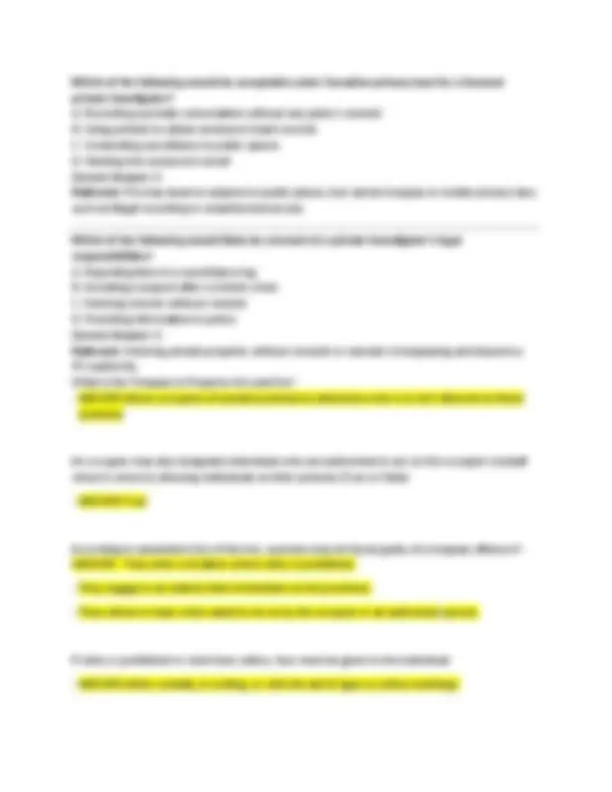
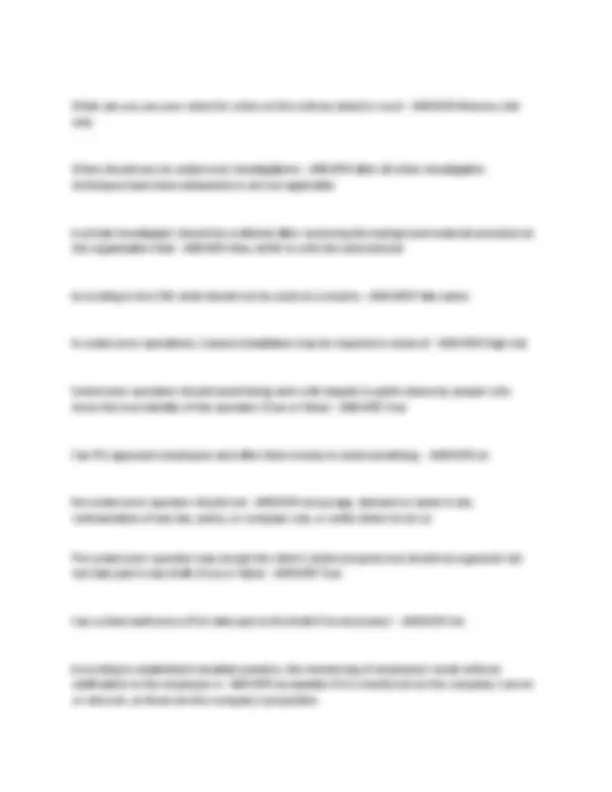
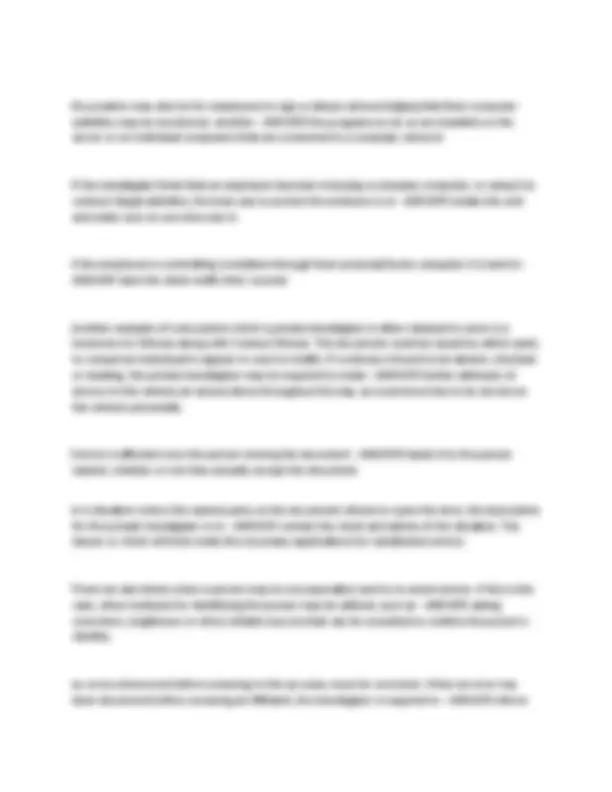
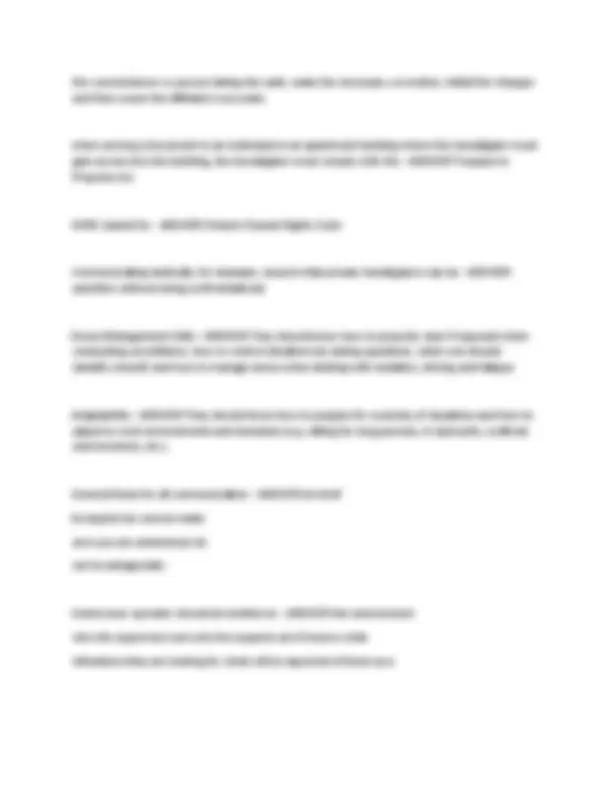
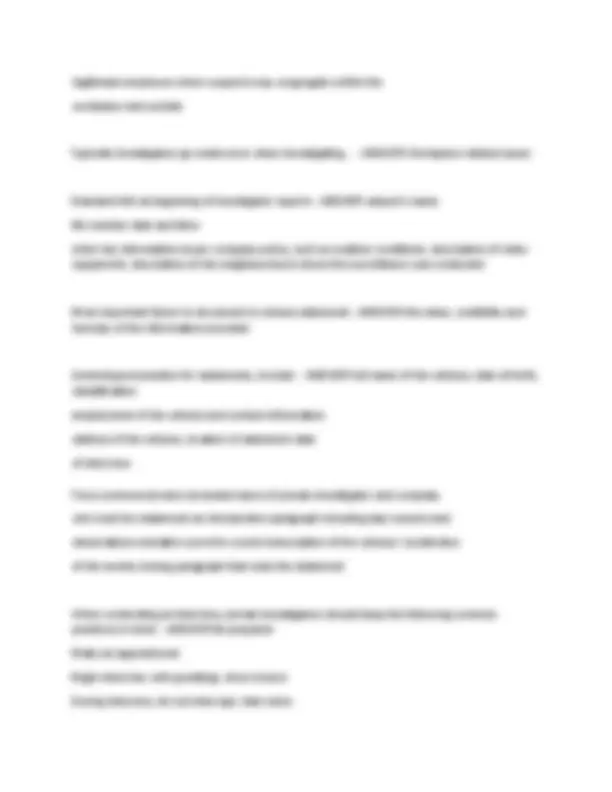
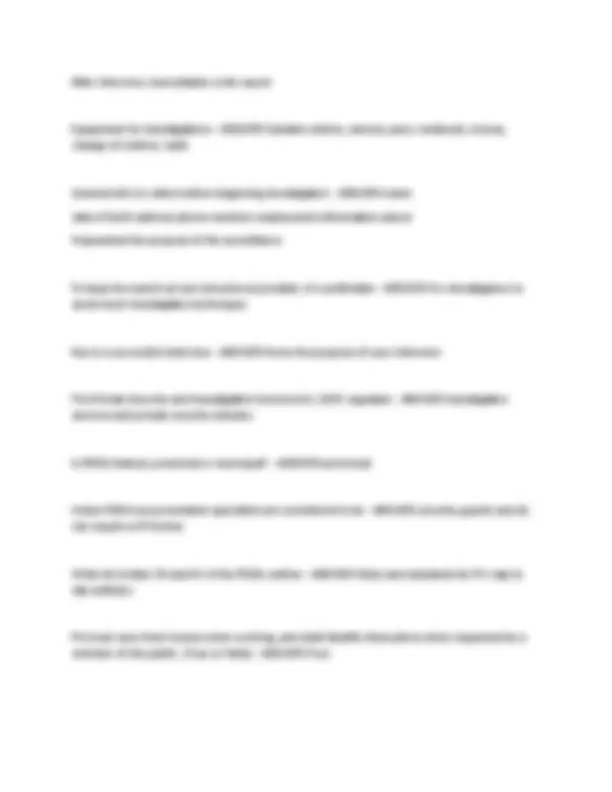
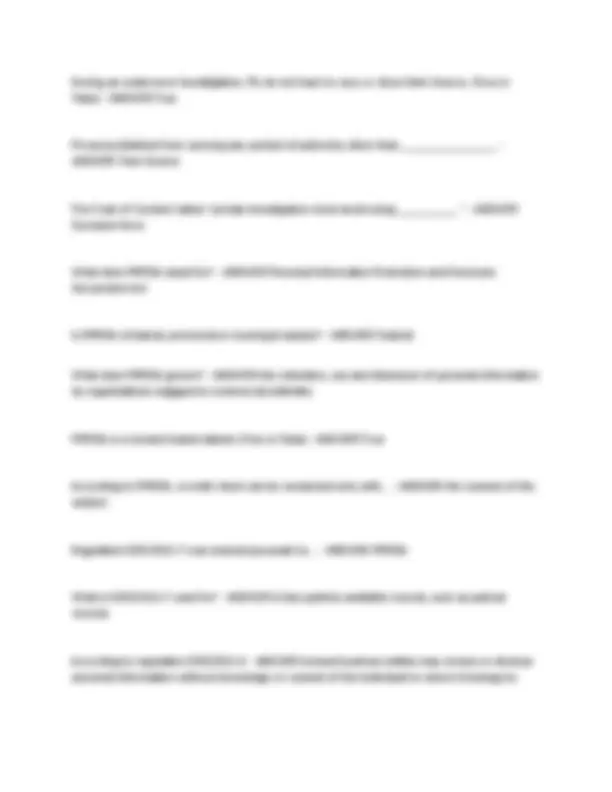
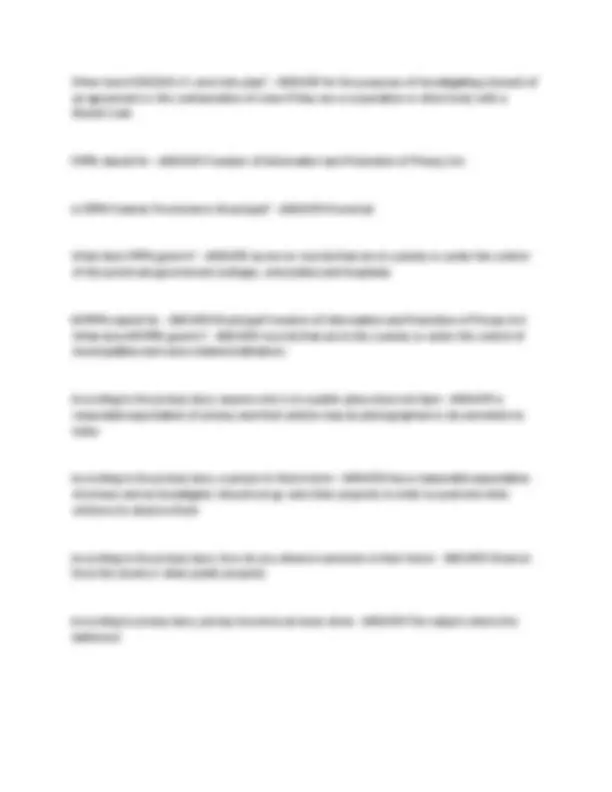
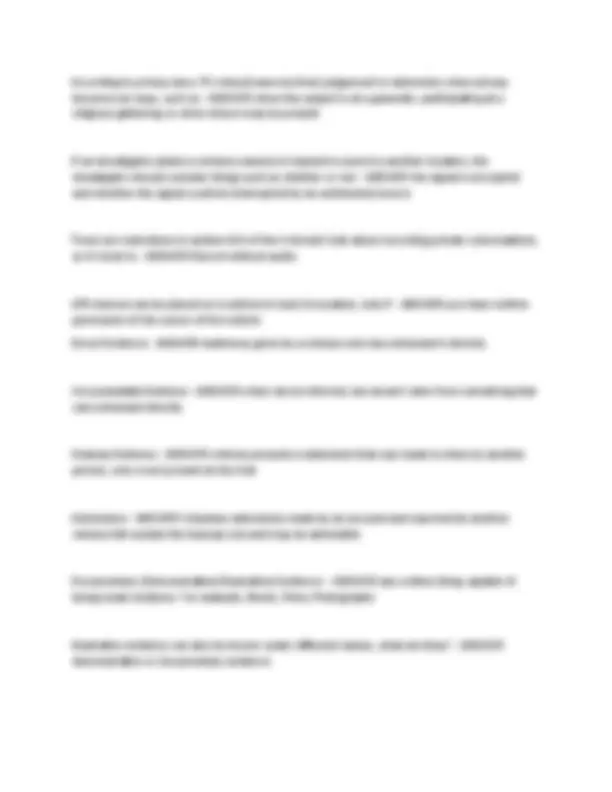
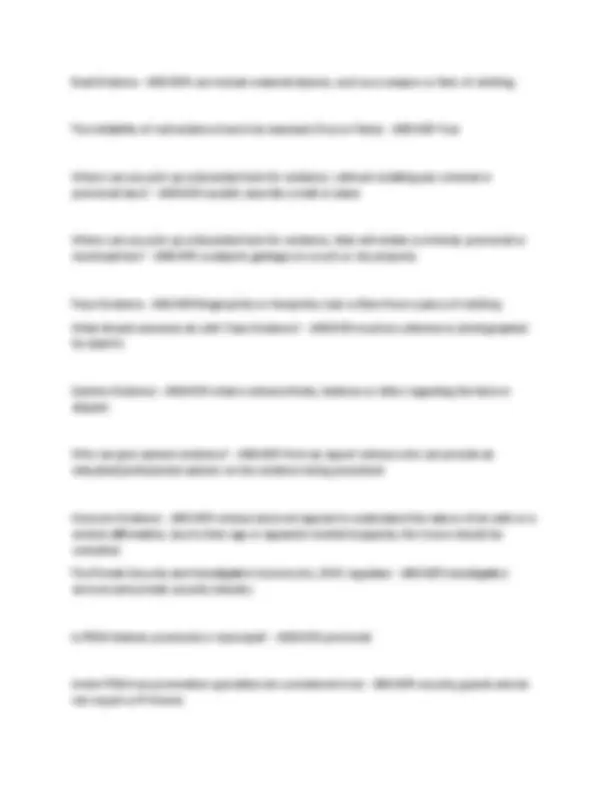
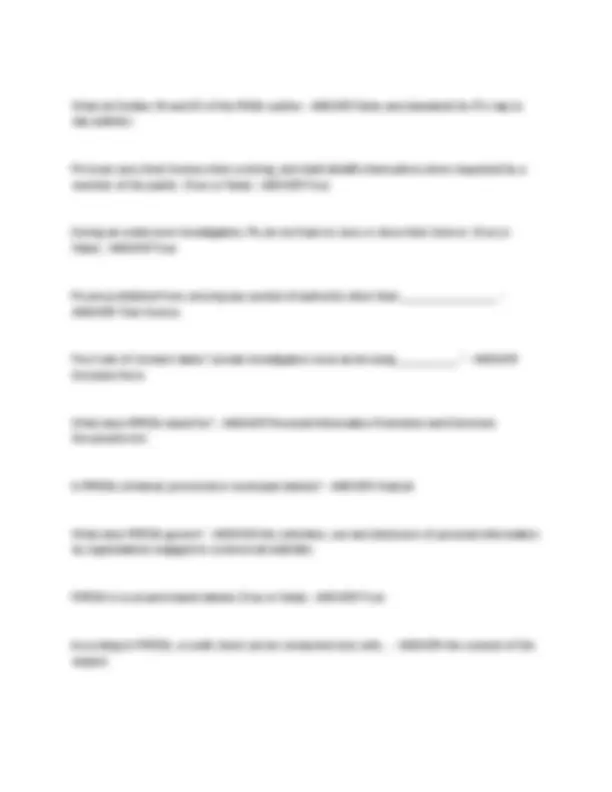
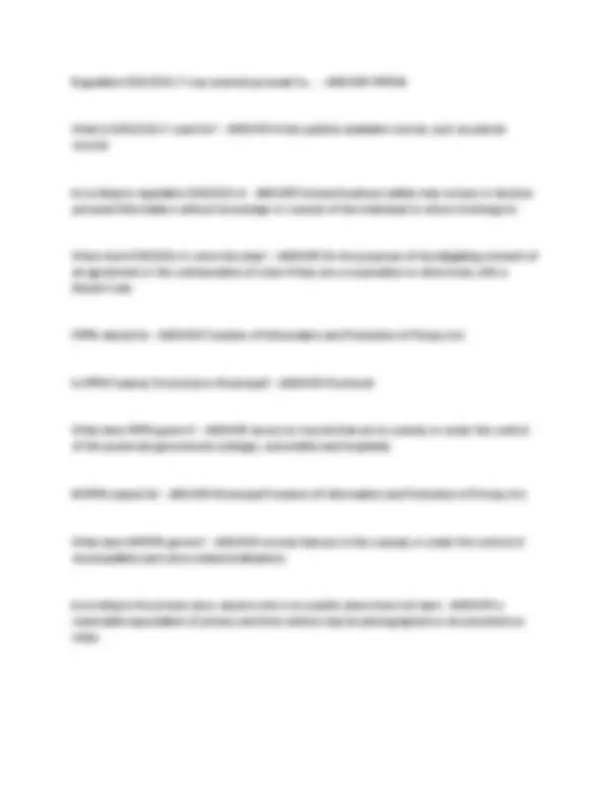
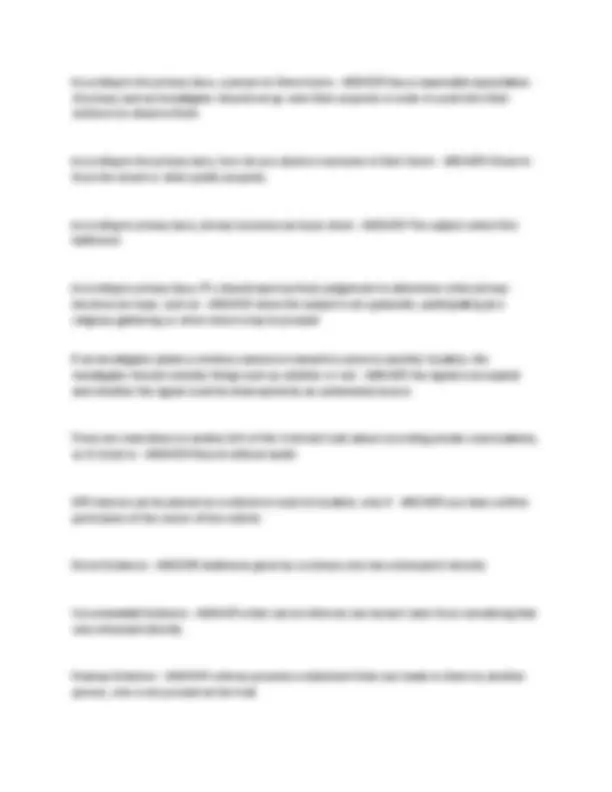
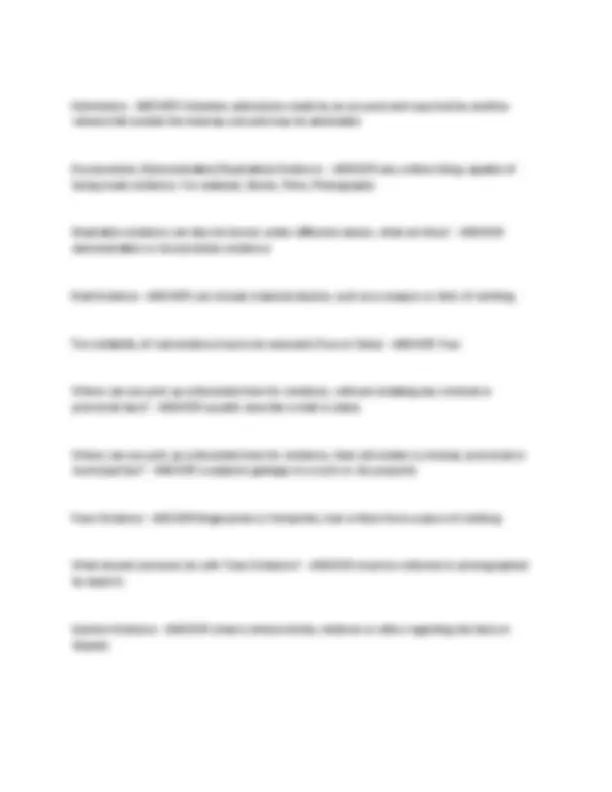

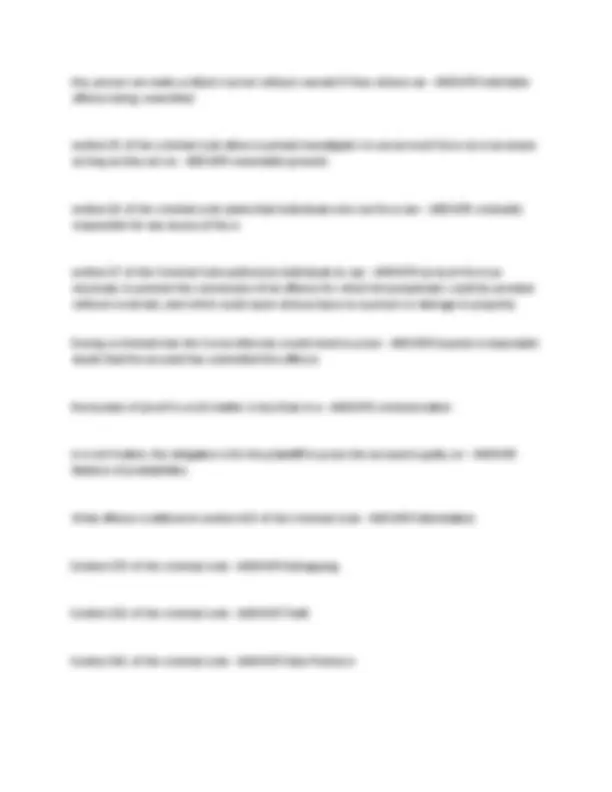
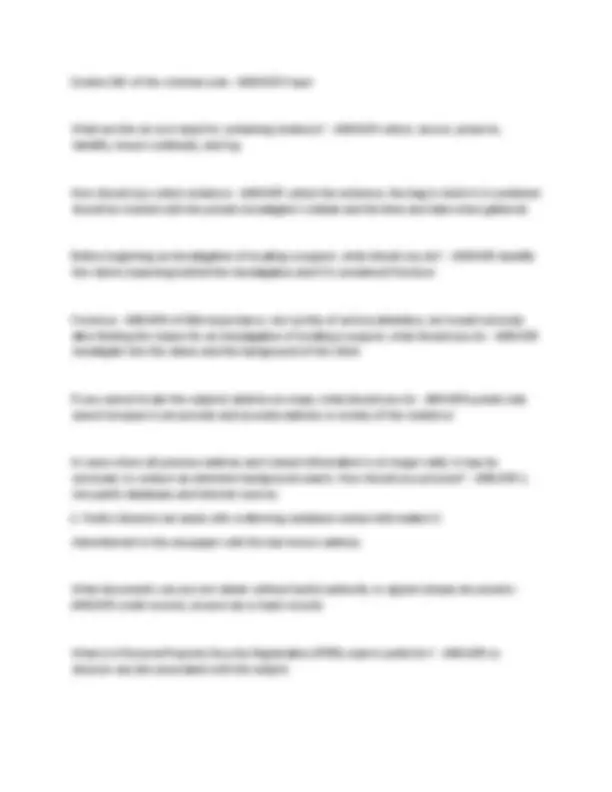
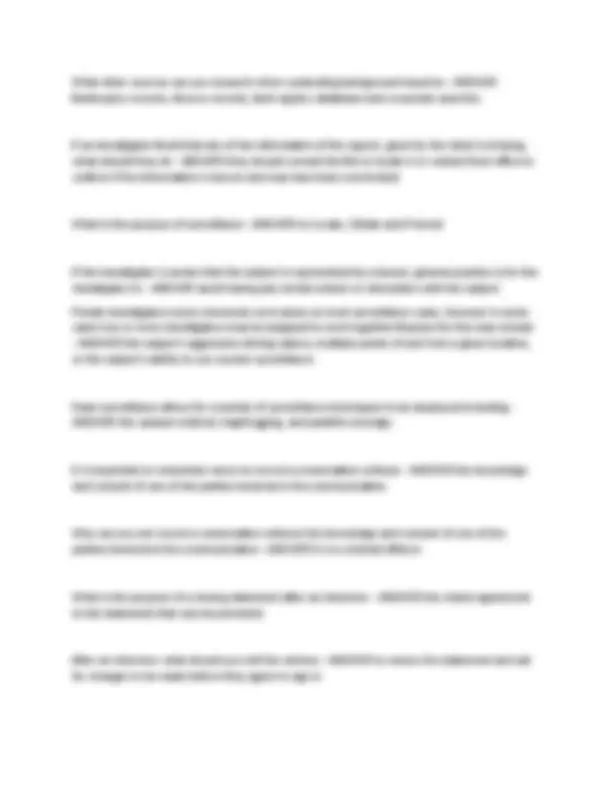
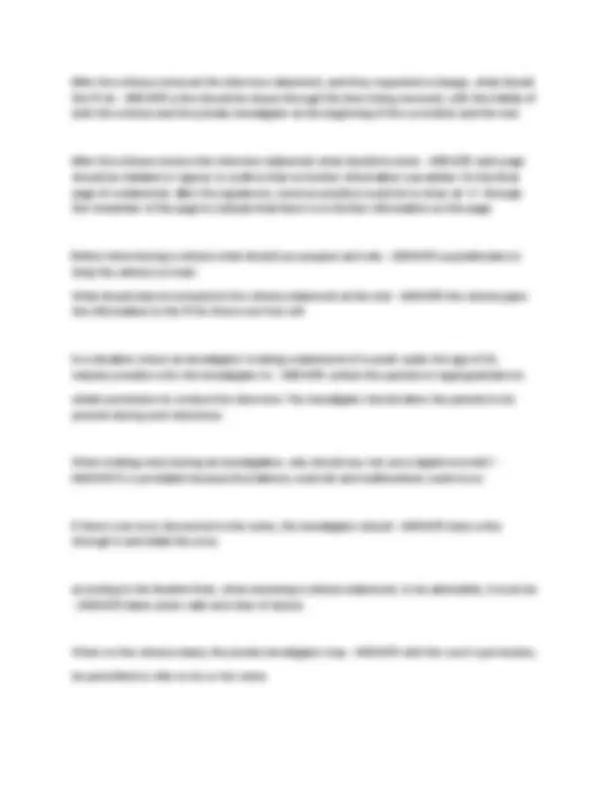
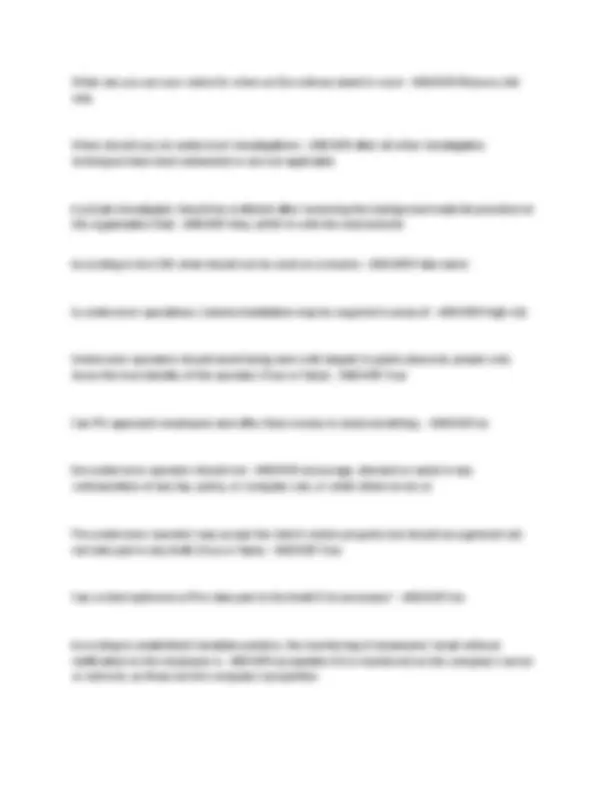
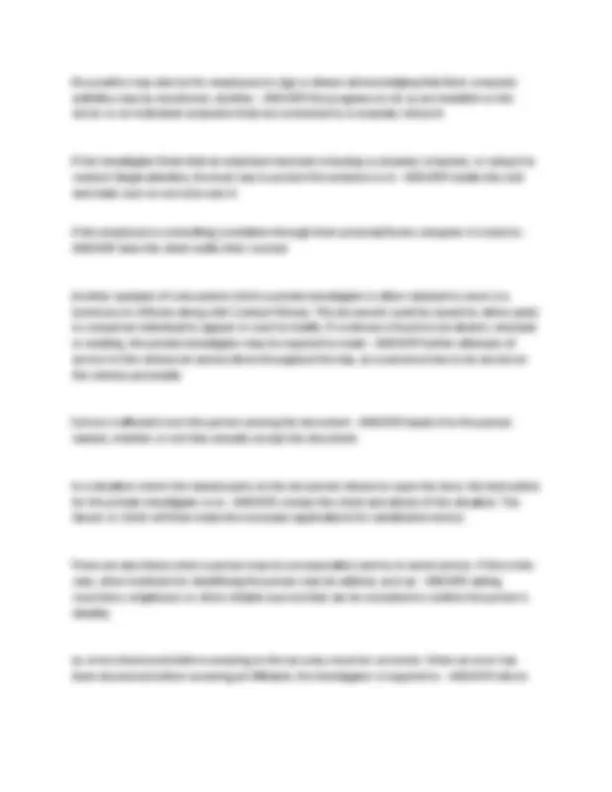
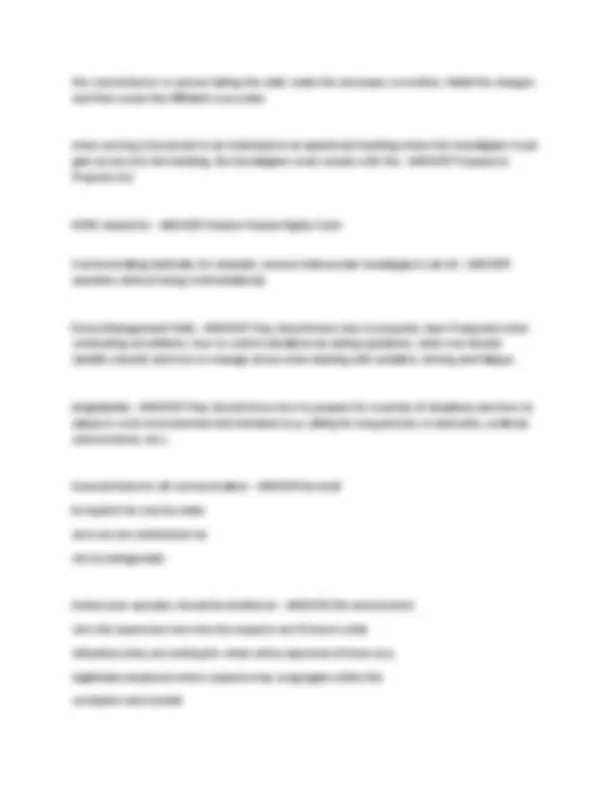
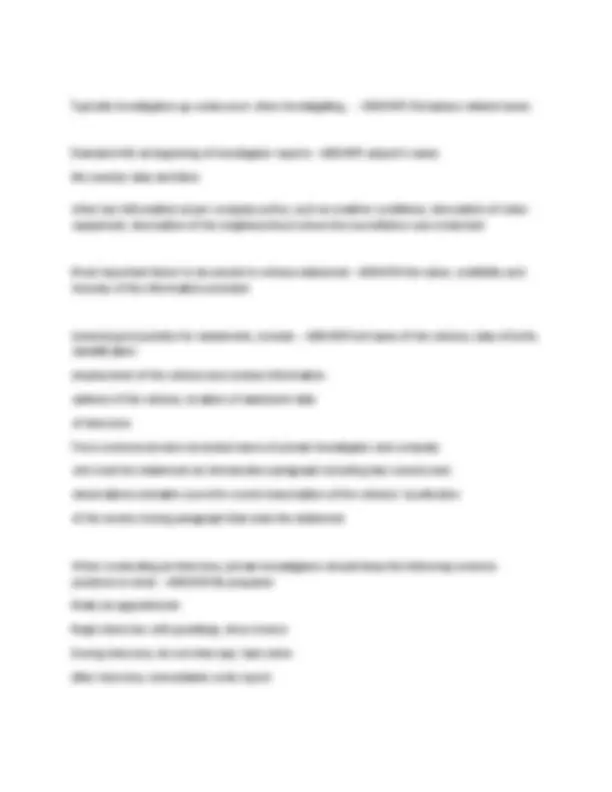
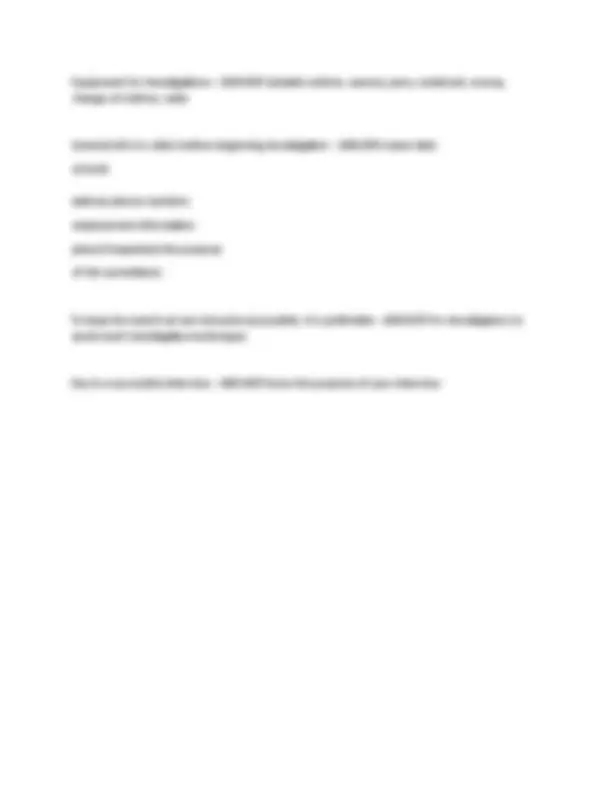


Study with the several resources on Docsity

Earn points by helping other students or get them with a premium plan


Prepare for your exams
Study with the several resources on Docsity

Earn points to download
Earn points by helping other students or get them with a premium plan
Community
Ask the community for help and clear up your study doubts
Discover the best universities in your country according to Docsity users
Free resources
Download our free guides on studying techniques, anxiety management strategies, and thesis advice from Docsity tutors
Persons in violation of section 2 of the Trespass to Property Act may be arrested with or without a warrant? A. Only with a warrant B. Without a warrant C. After police permission D. Only by a police officer Correct Answer: B. Without a warrant Rationale: Section 2 allows for warrantless arrests if a person is found trespassing under specific conditions. A person who arrests someone under the authority of the Trespass to Property Act must contact: A. A lawyer immediately B. A supervisor C. The police as soon as possible and deliver the individual to a police officer D. The complainant Correct Answer: C. The police as soon as possible and deliver the individual to a police officer Rationale: The Act requires the person making the arrest to notify and transfer custody to law enforcement promptly.
Typology: Exams
1 / 48

This page cannot be seen from the preview
Don't miss anything!









































Persons in violation of section 2 of the Trespass to Property Act may be arrested with or without a warrant? A. Only with a warrant B. Without a warrant C. After police permission D. Only by a police officer Correct Answer: B. Without a warrant Rationale: Section 2 allows for warrantless arrests if a person is found trespassing under specific conditions. A person who arrests someone under the authority of the Trespass to Property Act must contact: A. A lawyer immediately B. A supervisor C. The police as soon as possible and deliver the individual to a police officer D. The complainant Correct Answer: C. The police as soon as possible and deliver the individual to a police officer Rationale: The Act requires the person making the arrest to notify and transfer custody to law enforcement promptly. What does section 494 of the Criminal Code describe? A. Arrest with a warrant B. Police authority during searches C. When it is appropriate for a member of the public to make an arrest D. The use of firearms by security Correct Answer: C. When it is appropriate for a member of the public to make an arrest Rationale: Section 494 outlines the rules for citizen’s arrest. Any person can make a citizen's arrest without warrant if they witness an: A. Act of vandalism B. Summary conviction offence C. Indictable offence being committed
D. Argument in public Correct Answer: C. Indictable offence being committed Rationale: Citizen's arrest provisions apply to indictable offences only. Section 25 of the Criminal Code allows a private investigator to use as much force as is necessary as long as they act on: A. Instructions B. Personal judgment C. Reasonable grounds D. Orders from the client Correct Answer: C. Reasonable grounds Rationale: The law requires the use of force to be based on reasonable grounds. Section 26 of the Criminal Code states that individuals who use force are: A. Exempt from legal action B. Protected under common law C. Criminally responsible for any excess of force D. Subject to review only Correct Answer: C. Criminally responsible for any excess of force Rationale: Individuals are accountable if the force used is excessive. Section 27 of the Criminal Code authorizes individuals to use: A. Deadly force in all circumstances B. Any means necessary C. As much force as necessary to prevent an offence that could result in arrest without warrant and serious harm D. Force with police approval only Correct Answer: C. As much force as necessary to prevent an offence that could result in arrest without warrant and serious harm Rationale: This section applies only in specific serious situations. During a criminal trial, the Crown Attorney would need to prove: A. On a balance of probabilities B. That there was a motive C. Beyond a reasonable doubt that the accused committed the offence D. That the accused has a criminal record Correct Answer: C. Beyond a reasonable doubt that the accused committed the offence Rationale: This is the high standard of proof required in criminal cases.
Section 361 of the Criminal Code refers to: A. Embezzlement B. Fraud C. False Pretence D. Burglary Correct Answer: C. False Pretence Rationale: False pretence is specifically defined in section 361. Section 380 of the Criminal Code pertains to: A. Mischief B. Fraud C. Robbery D. Forgery Correct Answer: B. Fraud Rationale: Section 380 deals with fraud-related offences. What are the six core steps for containing evidence? A. Analyze, file, verify, process, report, secure B. Collect, secure, preserve, identify, ensure continuity, and log C. Scan, store, seal, secure, tag, and archive D. Record, retrieve, tag, seal, report, archive Correct Answer: B. Collect, secure, preserve, identify, ensure continuity, and log Rationale: These are standard practices for maintaining the integrity of evidence. How should you collect evidence? A. Collect and send it by mail B. Keep it in your personal bag C. Mark the bag with initials, date, and time D. Have the client seal it Correct Answer: C. Mark the bag with initials, date, and time Rationale: Proper identification ensures evidence continuity and integrity. Before beginning an investigation to locate a suspect, what should you do? A. Contact police B. Locate the suspect's family C. Identify the client's reasoning and assess if it's frivolous D. Visit the location Correct Answer: C. Identify the client's reasoning and assess if it's frivolous Rationale: It’s essential to evaluate the legitimacy of the request before proceeding.
Frivolous means: A. Dangerous B. Of little importance C. Valid D. Reliable Correct Answer: B. Of little importance Rationale: Frivolous claims are not serious or important. After finding the reason for an investigation, what should you do? A. Start surveillance B. Interview the suspect C. Investigate client claims and background D. Notify authorities Correct Answer: C. Investigate client claims and background Rationale: It ensures ethical standards are met. If you cannot locate the subject's address on maps, what should you do? A. Visit local landmarks B. Ask neighbors C. Do a postal code search D. Skip the address Correct Answer: C. Do a postal code search Rationale: Postal codes can help narrow down the area. How should you proceed if all prior address/contact info is invalid? A. Drop the case B. Ask the subject C. Use public databases, libraries, and advertise in newspapers D. Contact law enforcement Correct Answer: C. Use public databases, libraries, and advertise in newspapers Rationale: These are valid tools for extensive background searches. What documents can you not obtain without lawful authority or signed release? A. Vehicle ownership B. Social media history C. Credit records, tax, or bank records D. Voter registration Correct Answer: C. Credit records, tax, or bank records Rationale: These are protected under privacy laws.
Reasons multiple investigators may be used include: A. Budget restrictions B. The subject’s aggressive driving, multiple exits, or counter-surveillance C. Lack of client trust D. Insurance claims Correct Answer: B. The subject’s aggressive driving, multiple exits, or counter-surveillance Rationale: Complex surveillance situations may need a team approach. Team surveillance allows techniques such as: A. Vehicle tagging B. Home wiretapping C. Caravan method, leapfrogging, parallel coverage D. Air drone monitoring Correct Answer: C. Caravan method, leapfrogging, parallel coverage Rationale: These are standard team surveillance techniques. Never record a conversation without: A. A hidden microphone B. The knowledge and consent of one party C. A camera present D. Email confirmation Correct Answer: B. The knowledge and consent of one party Rationale: Recording without consent is illegal. Why is recording a conversation without consent not allowed? A. It's immoral B. It can be used against you C. It is a criminal offence D. It’s poor etiquette Correct Answer: C. It is a criminal offence Rationale: It violates wiretap and privacy laws. Purpose of a closing statement after an interview is to: A. End the conversation politely B. Collect a signature C. Get the client’s agreement to the statement D. Determine guilt Correct Answer: C. Get the client’s agreement to the statement Rationale: It finalizes and validates the interview summary.
After an interview, what should you tell the witness? A. Keep it confidential B. Leave immediately C. Review and request changes before signing D. File a report Correct Answer: C. Review and request changes before signing Rationale: Ensures the statement reflects their account accurately. If a change is requested in the witness statement, the PI should: A. Write over the old text B. Start a new form C. Draw a line through the item and initial it with the witness D. Delete the change Correct Answer: C. Draw a line through the item and initial it with the witness Rationale: This maintains record integrity. After reviewing a statement, each page should be: A. Dated and sent to client B. Scanned C. Initialed or signed, and the final page marked to prevent further addition D. Filed with police Correct Answer: C. Initialed or signed, and the final page marked to prevent further addition Rationale: Prevents tampering or unauthorized changes. Before interviewing a witness, you should prepare: A. A microphone B. A police report C. A questionnaire to keep them on track D. A confidentiality clause Correct Answer: C. A questionnaire to keep them on track Rationale: Helps guide the interview efficiently. What should also be included in a witness statement at the end? A. The client’s name B. Statement was voluntary C. PI’s credentials D. Suspect’s identity Correct Answer: B. Statement was voluntary Rationale: Confirms that the witness was not coerced.
When on the witness stand, the private investigator may: A. Read the entire report aloud B. Refuse to answer questions C. With the court's permission, be permitted to refer to his or her notes D. Give opinions based on personal judgment Correct Answer: C Rationale: A private investigator may, with the court’s permission, refer to their notes to ensure accuracy while testifying. According to the Ibrahim Rule, when assessing a witness statement, to be admissible, it must be: A. Written in front of a police officer B. Typed and notarized C. Taken under oath and clear of duress D. Reviewed by a judge Correct Answer: C Rationale: The Ibrahim Rule states that a statement must be voluntary, made without coercion, and under oath to be admissible in court. If there is an error discovered in the notes, the investigator should: A. Erase it completely B. Tear out the page C. Draw a line through it and initial the error D. Rewrite the whole page Correct Answer: C Rationale: Errors in investigative notes should be corrected by drawing a single line through the mistake and initialing it to maintain integrity. When making notes during an investigation, why should you not use a digital recorder? A. It’s illegal B. It distracts the witness C. It is unreliable because the batteries could die and malfunctions could occur D. It is too expensive Correct Answer: C Rationale: Digital recorders can malfunction or run out of power, making handwritten notes a more reliable method for preserving evidence. In a situation where an investigator is taking a statement of a youth under the age of 18, industry practice is for the investigator to: A. Conduct the interview without delay B. Obtain consent from the school principal C. Contact the parents or legal guardians and allow them to be present during the interview D. Wait until the youth turns 18 Correct Answer: C
Rationale: Ethical practice requires parental or guardian consent when interviewing a minor, and their presence is encouraged to ensure transparency. What should also be included in the witness statement at the end? A. The date of the interview B. The investigator’s full report C. The witness gave the information to the PI of their own free will D. The location of the incident Correct Answer: C Rationale: It is essential to note that the witness provided the information voluntarily, to ensure the statement’s admissibility. Before interviewing a witness what should you prepare and why? A. Background report, to establish credibility B. Camera, to record the session C. A questionnaire, to keep the witness on track D. A timeline, to assess urgency Correct Answer: C Rationale: A questionnaire helps guide the interview and ensures all necessary points are addressed clearly and efficiently. After the witness reviews the interview statement, what should be done? A. Send the statement to the client immediately B. Have the witness sign only the last page C. Each page should be initialed or signed; draw an “x” through any unused portion of the final page D. Attach additional blank pages for future use Correct Answer: C Rationale: This procedure helps verify that no pages were altered or added after the witness reviewed the statement. After the witness reviewed the interview statement, and they requested a change, what should the PI do? A. Erase the original and rewrite B. Create a second version C. Draw a line through the item being removed, and initial both ends of the correction D. Ignore minor corrections Correct Answer: C Rationale: This maintains the integrity of the original document while showing transparency in the correction process. After an interview, what should you tell the witness? A. Not to discuss the case B. That their identity will be revealed C. To review the statement and ask for changes before signing
Rationale: In the absence of bylaws, a PI can legally collect abandoned or discarded items from public spaces, as they are no longer considered private property. What does the term "chain of custody" refer to in investigations? A. A type of legal custody of suspects B. The sequence of transfers of physical evidence C. The organizational chart of an investigative firm D. The order in which interviews are conducted Correct Answer: B Rationale: Chain of custody refers to the documented process of handling, storing, and transferring evidence to ensure it remains uncontaminated and admissible. Which of the following would NOT be an acceptable method of securing physical evidence? A. Locked cabinet with access logs B. Unattended desk drawer C. Sealed evidence bag in secure storage D. Locked briefcase held by the investigator Correct Answer: B Rationale: Leaving evidence in an unattended desk drawer is not secure and risks contamination or unauthorized access, making it unacceptable. When taking photographs as part of an investigation, what is essential to include for each photo? A. A digital signature B. The photographer’s name and signature C. A caption with time, date, location, and context D. A watermark of the PI firm Correct Answer: C Rationale: Each photograph should be documented with details such as date, time, location, and context to verify authenticity and investigative relevance. What is the recommended practice for labeling evidence collected at a scene? A. Label only if client requests B. Use initials only for confidentiality C. Use clear labels including date, time, location, and collector’s name D. Use color-coded stickers only Correct Answer: C Rationale: Accurate and detailed labeling ensures proper identification and traceability of evidence throughout the investigation.
When conducting surveillance, what is one key rule for avoiding detection? A. Stay directly behind the subject B. Frequently change clothing C. Use disguises and switch vehicles regularly D. Maintain distance and avoid obvious patterns Correct Answer: D Rationale: Maintaining distance and avoiding predictable patterns helps the investigator remain unnoticed and avoid compromising the surveillance. When interviewing a hostile witness, what is the best strategy? A. Confront the witness immediately B. Avoid direct questioning C. Remain calm, neutral, and stick to factual questions D. Record the conversation without permission Correct Answer: C Rationale: Staying calm and focusing on facts reduces conflict and increases the chance of getting useful, reliable information from a reluctant witness Persons in violation of section 2 of the Trespass to Property Act may be arrested with or without a warrant A. With a warrant only B. Without a warrant C. Only by the police D. Only on private property Correct Answer: B Rationale: Section 2 allows for arrest without a warrant when someone is found trespassing, as it is a summary conviction offence. A person who arrests someone under the authority of the Trespass to Property Act must contact: A. A lawyer before proceeding B. The person’s employer C. The police as soon as possible and deliver the individual to a police officer D. The subject’s family Correct Answer: C Rationale: The law requires that a citizen’s arrest be immediately followed by police involvement to ensure proper legal handling. What does section 494 of the Criminal Code describe? A. How to apply for a warrant B. Rules for public protests
Rationale: Section 27 allows the use of necessary force to prevent serious offences or harm, if arrest without warrant would be legal. During a criminal trial, the Crown Attorney would need to prove: A. A motive for the crime B. The existence of a witness C. Beyond a reasonable doubt that the accused committed the offence D. That the investigator was present Correct Answer: C Rationale: The standard of proof in criminal cases is "beyond a reasonable doubt" to ensure fairness and protect the accused. The burden of proof in a civil matter is less than in a: A. Municipal offence B. Provincial offence C. Criminal matter D. Summary offence Correct Answer: C Rationale: Civil cases require only proof on a balance of probabilities, whereas criminal cases require proof beyond a reasonable doubt. In a civil matter, the obligation is for the plaintiff to prove the accused is guilty on: A. Beyond reasonable suspicion B. Reasonable doubt C. Balance of probabilities D. Clear and convincing evidence Correct Answer: C Rationale: Civil proceedings rely on the "balance of probabilities," meaning it is more likely than not that the claim is true. What offence is defined in Section 423 of the Criminal Code? A. Extortion B. Intimidation C. Fraud D. Assault Correct Answer: B Rationale: Section 423 addresses intimidation, including threats or actions that prevent lawful conduct.
Section 279 of the Criminal Code defines: A. Harassment B. Vandalism C. Kidnapping D. Break and enter Correct Answer: C Rationale: This section outlines the criminal definition and legal consequences of kidnapping. Section 322 of the Criminal Code refers to: A. Burglary B. Theft C. Misrepresentation D. Arson Correct Answer: B Rationale: Section 322 defines theft and its elements under Canadian criminal law. Section 361 of the Criminal Code defines: A. Forgery B. False pretence C. Criminal mischief D. Breach of trust Correct Answer: B Rationale: False pretence involves obtaining something by deliberately misleading someone with false information. Section 380 of the Criminal Code defines: A. Fraud B. Break and enter C. Embezzlement D. Bribery Correct Answer: A Rationale: Fraud under Section 380 includes deceitful or dishonest conduct meant to cause loss or gain. What are the six core steps for containing evidence? A. Identify, interrogate, bag, lock, label, report B. Collect, secure, preserve, identify, ensure continuity, and log C. Photograph, fingerprint, record, destroy, verify, file D. Collect, copy, analyze, destroy, file, report Correct Answer: B
A. Wait for new info B. Visit known locations C. Use public databases, libraries, and consider newspaper ads D. Ask the police for help Correct Answer: C Rationale: Public and archival resources can provide leads when other data is outdated or incorrect. What documents can you not obtain without lawful authority or signed release documents? A. Property tax records B. Birth certificates C. Credit records, income tax, or bank records D. Marriage certificates Correct Answer: C Rationale: Accessing these sensitive financial records without consent or legal authority is illegal. What is a Personal Property Security Registration (PPSR) search useful for? A. Finding criminal records B. Locating lost relatives C. Discovering any lien associated with the subject D. Viewing property tax statements Correct Answer: C Rationale: A PPSR search reveals any secured interests or liens on personal property, useful in background investigations. What other sources can you research when conducting background inquiries? A. Driving history and passport records B. Credit scores and mortgage balances C. Bankruptcy records, divorce records, land registry databases, and corporate searches D. Social media only Correct Answer: C Rationale: These official records provide verifiable information useful in comprehensive background checks. If an investigator finds that any of the information of the suspect, given by the client is missing, what should they do? A. Ignore it B. Call the subject directly C. Consult the file or contact their office to confirm if it was overlooked
D. Search the internet Correct Answer: C Rationale: The investigator should verify the data through internal records before proceeding. What is the purpose of surveillance? A. To record conversations B. To Locate, Obtain, and Prevent C. To interrogate suspects D. To create legal documents Correct Answer: B Rationale: Surveillance is used to gather information, confirm activities, and deter criminal acts. If the investigator is aware that the subject is represented by a lawyer, general practice is for the investigator to: A. Notify the police B. Contact the subject directly C. Avoid having any verbal contact or interaction with the subject D. Interview the subject immediately Correct Answer: C Rationale: To avoid violating legal rights or privilege, PIs should avoid contact with represented individuals. Private investigators most commonly work alone on most surveillance cases, however, in some cases two or more investigators may be assigned. Reasons include: A. It's easier to finish faster B. Investigators prefer company C. Subject’s aggressive driving, multiple exits, or counter-surveillance ability D. To save money Correct Answer: C Rationale: Complex or evasive subjects may require multiple investigators for effective surveillance. Team surveillance allows for a variety of surveillance techniques to be employed including: A. Telepathy and instincts B. Hiding in plain sight C. The caravan method, leapfrogging, and parallel coverage D. Stationary focus only Correct Answer: C Rationale: These methods allow teams to follow subjects effectively without detection.